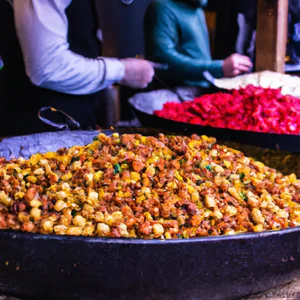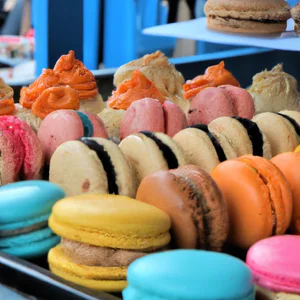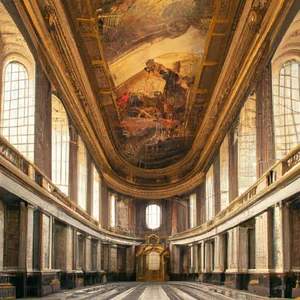Book your experience
Notting Hill: much more than a film, discovering the most colorful neighborhood in London
Notting Hill: it’s not just a film, it’s a real journey into the liveliest and most colorful neighborhood in London!
You know, when I think of Notting Hill, that feeling of walking through the streets and feeling almost transported to another world comes to mind. It’s like a painting come to life, with pastel-colored houses that seem to scream “Look, I’m here!” And let’s not talk about the markets, where you can really find everything: from vintage objects to foods that make your mouth water.
Once, while wandering there, I tasted a dessert that I will never forget. It was a sort of chocolate cake, but with a touch of spice that made it unique. And while I was eating it, I thought: “Wow, life tastes different here!”
Well, the beauty of Notting Hill is precisely this: it is a mix of cultures, colors and flavours. I don’t know, maybe it’s the atmosphere that makes you feel at home, even if you’re far from home. Of course, the film with Julia Roberts and Hugh Grant shed some light on this place, but believe me, there is much more to discover!
Plus, there are those markets on Portobello Road which, oh my God, are a true paradise for lovers of unique things. Do you ever see something and think, “I absolutely have to have that!”? Well, there it is practically impossible to resist.
Ultimately, Notting Hill is like a big hug, a place where stories intertwine and where anyone can find their own special corner. In short, if you have the chance to go there, don’t think twice! But, you know, maybe it’s just my opinion… who knows?
Discover the vibrant markets of Notting Hill
A personal experience of colors and scents
I still remember my first visit to Portobello Road Market, an experience that awakened all my senses. As I walked along the stalls, the scent of exotic spices mingled with the sweet aroma of fresh baked goods. Every corner seemed to tell a story, from the antique sellers displaying unique pieces, to the fruit and vegetable stalls glistening in the sun. This is not just a visit, but an immersion in a microcosm of culture and daily life.
Practical and up-to-date information
Portobello Road Market is open every day, but it is at its peak at the weekend, with over 1,000 vendors displaying their wares. Every Saturday, the antiques market attracts enthusiasts from all corners of London, while on Sundays it transforms into a bustling bazaar of fresh produce and local crafts. For further details, you can visit the official website of Portobello Market here.
An insider tip
If you want an authentic experience, I recommend visiting the market on Fridays. On this less crowded day, you can stroll leisurely and discover hidden stalls, as well as interact more easily with the vendors, many of whom are happy to share their passion and the history of their products.
The cultural impact of Portobello Road
Portobello Road is not just a market; it is a symbol of Notting Hill’s cultural diversity. Born as a fruit and vegetable market in the 19th century, it has become an important center of cultural and commercial exchange. Today, it represents a crossroads of cultures, where products from all over the world can be found, reflecting the neighborhood’s evolution from a predominantly residential area to a vibrant multicultural hub.
Sustainable tourism practices
Many vendors at Portobello Road Market are committed to sustainable practices. From the sale of organic and zero km products to the promotion of local craftsmanship, the market is an excellent example of how tourism can be responsible and respectful of the environment. Purchasing from these sellers not only supports the local economy, but also contributes to a more sustainable consumption pattern.
A lively and engaging atmosphere
As you walk among the stalls, let yourself be enveloped by the bright colors and sounds of the market. Vendors offering free food samples, street musicians playing catchy tunes, and the laughter of children playing create a festive and welcoming atmosphere. It is a place where time seems to stop, inviting you to explore without haste.
An activity worth trying
Don’t miss the opportunity to taste delicious street food. I highly recommend you try the specialties of one of the many kiosks offering ethnic food. Spanish paella, Mexican tacos or Moroccan sweets are just some of the delights you can enjoy while strolling.
Myths and misconceptions
A common misconception is that Portobello Road Market is just a tourist attraction. In reality, it is a lively place experienced by Notting Hill residents, who frequent it to do their shopping and socialise. This interaction between locals and visitors enriches the experience of every person who ventures into the market.
A final reflection
As you leave Portobello Road Market, ask yourself: What does community mean to you? The lively interaction between vendors and customers, combined with the celebration of cultural diversity, offers a new perspective on how tourism can bring people together in ways significant. Notting Hill, with its pulsating market, is not just a destination to visit, but a place to experience.
Stroll among the iconic colorful houses
Walking the streets of Notting Hill, I found myself immersed in a world of vibrant colors and fascinating architecture. Each house, with its pastel shades that vary from baby pink to sky blue, tells a unique story. I remember one afternoon when, while taking photos of these architectural wonders, a resident invited me to discover the private garden of one of the historic houses. This experience opened my eyes to the authenticity of the neighborhood, often hidden behind the famous Portobello market.
Practical information
The colorful houses of Notting Hill are not only a feast for the eyes, but also a key part of the neighbourhood’s history. The most iconic streets, such as Westbourne Grove and Lancaster Road, are easily accessible by tube (Notting Hill Gate stop is the closest). Don’t forget to bring your camera; every corner offers a unique opportunity to capture the beauty of this place. According to London’s official tourism website, the neighborhood is a hotspot for its vibrant colours and historic architecture.
Unconventional advice
A little secret that only locals know is that during the week, the streets are much less crowded than on weekends. If you want to enjoy the tranquility and have the opportunity to interact with the residents, an early morning walk will give you a more intimate and authentic experience. You might even come across artists or artisans at work, creating an atmosphere that seems almost suspended in time.
Cultural and historical impact
Notting Hill houses aren’t just beautiful; they are also symbols of a vibrant and diverse community. In the 1960s, the neighborhood became a center for Afro-Caribbean culture in London, helping to shape the place’s unique identity. This heritage is evident not only in the architecture but also in local traditions, such as the famous Notting Hill Carnival, which celebrates Caribbean culture and music.
Sustainability and responsible tourism
When exploring the colorful houses, consider adopting responsible tourism practices. Many residents are committed to preserving their environment, and some local initiatives encourage visitors to respect their spaces. Opting for walking tours rather than motorized vehicles is an easy way to help keep the air clean and respect the atmosphere of the neighborhood.
An experience worth trying
For an unforgettable experience, try visiting Portobello Market on a Saturday morning. As you wander among the colorful stalls, let yourself be inspired by the houses that surround you. You may discover a small cafe that offers spectacular views of the iconic colorful streets. Don’t forget to savor a delicious local coffee while enjoying the atmosphere.
Addressing the myths
A common misconception is that Notting Hill is just a superficial tourist destination, popular thanks to the film of the same name. However, the true essence of the neighborhood goes far beyond glamor and celebrities; it is a place of history, community and living culture. Don’t be fooled by the glossy images; here you will find an authenticity that is often overlooked.
A final reflection
Walking among the colorful houses of Notting Hill is more than just a photographic tour; it’s an opportunity to connect with a community that has so much to offer. What story awaits you behind the next colorful door you come across? The beauty of this place invites you to stop and reflect, to be inspired by the colors and stories that each house has to tell.
Hidden history: the cultural legacy of the neighborhood
A journey through time through the streets of Notting Hill
Walking through the streets of Notting Hill, I found myself in front of one of the neighborhood’s most iconic colorful houses, adorned with vibrant flowers and a welcoming smile. As I took a photo, a resident approached me, telling me stories of a time when the neighborhood was a center of cultural and social activity, a meeting place for different communities. This anecdote made me realize that around every corner of Notting Hill there is a story to discover, a cultural legacy that has shaped the identity of this lively neighbourhood.
A heritage to explore
Notting Hill is famous not only for its Portobello market and colorful houses, but also for its rich history. Originally a rural area, it became a center of immigration in the 19th century, welcoming communities from all over the world. The presence of Caribbean communities, for example, has created a vibrant culture, influencing local music, cuisine and traditions. Today, events such as Notting Hill Carnival celebrate this heritage and attract visitors from far and wide.
If you want to immerse yourself in the cultural history of the neighbourhood, I recommend visiting the Notting Hill Museum, a little gem that offers a great overview of local history. Located on one of the main streets, the museum hosts temporary and permanent exhibitions that tell the story of the evolution of the neighborhood and its communities. It’s an opportunity to see how the past continues to influence the present.
An insider tip: hidden murals
A little-known tip is to look for hidden murals in the neighborhood. Many visitors focus on the main streets, but as you explore less-traveled alleys, you may come across stunning works of art that tell stories of struggle, hope and community. Some of these murals were created by local artists and offer a unique insight into contemporary Notting Hill culture.
The cultural impact of an evolving neighborhood
The history of Notting Hill is an example of how a neighborhood can evolve, keeping its cultural identity alive. Its multicultural roots have allowed for a fusion of lifestyles, which is reflected not only in the architecture but also in the vibrant atmosphere that pervades the neighborhood. However, it is important to also recognize the challenges related to gentrification, which have led to significant changes in the social fabric of the community.
Sustainability and responsibility
When exploring Notting Hill, consider responsible tourism practices. Choose to support local shops and restaurants, take resident-led tours, and respect your surroundings. Small actions, like using public transport to get around the neighbourhood, can help preserve the beauty of Notting Hill for future generations.
An experience not to be missed
A must-do activity is a visit to Portobello Fair, where you can not only purchase antiques, but also hear stories from vendors and residents who have seen the neighborhood change over time. Don’t forget to tuck into a traditional Caribbean dish from one of the stalls, for a dining experience that tells the story of Notting Hill.
Myths and misconceptions
A common misconception is that Notting Hill is just a tourist destination for its markets and colorful houses. In reality, the neighborhood is a vibrant cultural hub with an active and deeply rooted community. It is essential to see beyond the surface and appreciate the stories and people that make this place unique.
A final reflection
As you stroll through the streets of Notting Hill, ask yourself: what stories could these colorful houses tell if they could talk? The beauty of this neighborhood lies not only in its bright colors, but also in its deep roots and its continuous evolution. Next time you visit, try to discover the hidden stories that make Notting Hill not just a place to see, but an experience to live.
Culinary delights: restaurants not to be missed
A journey through the flavors of Notting Hill
The first time I set foot in Notting Hill, I found myself in the heart of a bustling food market. A few steps from the famous Portobello Road, the enveloping scent of spices, together with the hiss of frying pans, immediately captured me. This is where I tasted the best chicken curry I had ever tried, served with a generous portion of basmati rice. This is just a taste of the culinary delights Notting Hill has to offer.
The unmissable restaurants
Notting Hill is a true oasis for food lovers. Among the most popular restaurants, The Ledbury, with its two Michelin stars, offers refined dishes that celebrate fresh, local ingredients. If you want a more casual experience, don’t miss Dishoom, which recreates the atmosphere of Bombay’s Indian restaurants, with plates to share and a great selection of chai. For those looking for something sweet, Salted Caramel is dessert heaven, famous for its decadent brownies.
An insider tip
If you want a truly authentic food experience, try visiting Portobello Green Market on Fridays, where you can find a selection of street foods representing different culinary cultures. Here, famous local chefs and cooking enthusiasts offer fresh and creative dishes. If you’re lucky, you might even stumble upon a live cooking demonstration!
Cultural heritage on your plate
Notting Hill’s food scene is a reflection of its rich cultural heritage. The neighborhood has always been a crossroads of different cultures, and its cuisine is testimony to this. The restaurants that dot the streets tell stories of migrations, fusions and intertwining culinary traditions, making every meal a journey through time and space.
Sustainability and responsibility
Many restaurants in Notting Hill embrace sustainability practices, seeking to reduce their environmental impact. Restaurants like The Grain Store are committed to using locally sourced and organic ingredients, promoting healthy, responsible eating. Choosing to eat in these places is not only a pleasure for the palate, but also a step towards more conscious tourism.
An invitation to explore
If you’re in Notting Hill, don’t miss the chance to join a local food tour. This way, you can enjoy a variety of typical dishes and discover fascinating stories behind each recipe. Tip: Book a tour that includes a visit to Portobello Road Market, where you can sample local specialties and interact with vendors.
Myths to dispel
A common misconception is that Notting Hill cuisine is exclusively expensive and high class. In fact, the area also offers many cheap and authentic options, from street food kiosks to local cafes, where you can enjoy delicious dishes without emptying your wallet.
Final reflection
Every time I think of Notting Hill, I can’t help but remember the flavor of the curry I tasted for the first time. Each dish tells a story, a deep cultural connection. Have you ever wondered what your next trip will taste like? Be amazed by the culinary delights of Notting Hill and discover how every bite can tell the story of an entire community.
Local events: Notting Hill Carnival
An unforgettable experience
I still remember the first time I attended the Notting Hill Carnival. It was an August day, the air was warm and vibrant, and as I approached the celebration, the sound of drums and laughter filled the atmosphere. The streets were invaded by a sea of colours; flamboyant costumes, dancers moving to the beat of Caribbean music, and the smell of delicious food coming from every corner. This isn’t just a party, it’s an experience that embodies the soul of Notting Hill.
Practical information
The Notting Hill Carnival is held every year over the Bank Holiday in August, attracting over a million visitors. It is one of the largest street festivals in Europe and celebrates the Caribbean culture of the local community. The main events take place in the streets of Notting Hill, with parades, live music and, of course, a selection of culinary delights. For up-to-date information, you can visit the official Notting Hill Carnival website, where you will find details on times and scheduled activities.
An insider tip
If you really want to soak up the atmosphere, try to arrive a day early to explore the preparations. Many artists and dance groups gather to refine their costumes and rehearse their numbers. These behind-the-scenes moments offer a unique and more intimate view into the festival and let you learn the stories of the people involved.
The cultural impact
Notting Hill Carnival has deep roots, dating back to the 1960s, when the Afro-Caribbean community sought to celebrate their culture and history in an often difficult urban context. Today, it is not only a cultural expression, but also a symbol of unity and diversity. The celebration attracts people from all over the world and represents an important moment of meeting and sharing.
Sustainability and responsible tourism
With the increase in visitors, it is essential that the Carnival promotes sustainability practices. Several local organizations are working to reduce the event’s environmental impact, such as using recyclable materials for costumes and food. Participating responsibly also means respecting local traditions and contributing positively to the community.
An immersion in colors and sounds
Imagine getting lost in the streets of Notting Hill, surrounded by a symphony of drums and voices. The colors of the costumes shine in the sun, and the energy is contagious. Every corner tells a story, every face reflects joy and pride. There is no better way to understand the true essence of this neighborhood than to participate in the Carnival.
An activity worth trying
If you have the opportunity, don’t miss the chance to join a local dance group for a Carnival preparation workshop. This experience will allow you to learn some dance steps and understand the traditions behind the choreography.
Myths to dispel
Many believe that Notting Hill Carnival is just a celebration of excess. In reality, it is a celebration of culture, art and community, where inclusion and respect are fundamental values. It’s a time when differences are celebrated, and the love of music and dance unites everyone.
Final reflection
After experiencing Carnival, I asked myself: How can we continue to celebrate diversity in our everyday communities? The beauty of events like this lies in their power to unite people of all backgrounds and make us appreciate the richness of our humanity. Are you ready to discover Notting Hill through its Carnival?
Authentic experiences: a coffee with the residents
An unexpected encounter
I vividly remember my first encounter with the Notting Hill neighbourhood: it was a sunny morning and I was lost among the picturesque streets. As I explored, I stopped at a small cafe run by an elderly couple, whose gazes told stories of decades of living there. With a warm smile, they invited me to sit at their table, and within minutes I found myself discussing everything from the changes in the neighborhood to the incredible cultural diversity that characterizes it. This encounter not only enriched my experience, but also opened a window into the daily lives of Notting Hill residents.
Practical information
If you want to have a similar experience, I recommend you visit Portobello Café, located along the famous Portobello Road market. Here, the bartenders and customers are often neighborhood residents, ready to share tips on where to go and what to see. It’s a great place to enjoy an authentic full English breakfast or a slice of home-baked cake, whilst immersing yourself in conversations that flow like coffee through cups.
An insider tip
One of Notting Hill’s best kept secrets is the Thursday Coffee. Every Thursday, residents gather for an informal chat and free coffee from a local café. It’s a perfect opportunity to get to know the people of the neighborhood and discover fascinating stories that you won’t find in tourist guides.
The cultural impact
This interaction with residents offers an insightful look into the history of Notting Hill, a neighborhood that has seen dramatic changes over the years. From a working-class area to a symbol of multiculturalism, the personal stories of residents are the beating heart of this iconic place, demonstrating how everyday experiences can enrich the narrative of an entire neighborhood.
Responsible tourism
Engaging with residents is not only a way to enrich your experience, but it is also a sustainable approach to tourism. Choosing to support small local businesses, such as family-run cafes and restaurants, helps keep the local economy alive and preserves the authenticity of the neighborhood.
Vivid atmosphere and language
Imagine sitting in a café overlooking one of Notting Hill’s narrow cobbled streets, with the smell of freshly brewed coffee mixing with that of fresh flowers sold by local vendors. Laughter and chatter intertwine in the air, creating a vibrant and welcoming atmosphere that reflects the warm hospitality of its inhabitants.
An experience worth trying
Don’t miss the opportunity to participate in a local cooking workshop, where you can prepare and taste typical dishes together with the residents. These events will not only allow you to enjoy Notting Hill cuisine, but also create unique connections with those who live here.
Myths to dispel
A common misconception about Notting Hill is that it is an exclusive and unaffordable neighbourhood. In fact, the community is extremely welcoming to visitors, and many residents enjoy sharing their stories and culture with anyone who wishes listen to them.
Final reflection
After experiencing coffee with Notting Hill residents, I asked myself: how many more stories and connections are there to discover in the places we visit? Next time you find yourself in a new neighbourhood, take a moment to stop, listen and immerse yourself in the lives of the people who live there. You may discover that the most authentic experiences are precisely those that are intertwined with the stories of those who call that place “home”.
Sustainability in Notting Hill: responsible tourism
When I first visited Notting Hill, I found myself strolling along the cobbled streets, immersed in the lively atmosphere of Portobello Market. As I savored delicious fresh fruit juice, I realized that this was not just about beauty and culture, but also a strong commitment to sustainability. Small shops and outdoor markets not only offer fresh, local products, but also support ethical business practices that respect the environment and surrounding communities.
Local sustainability practices
Notting Hill is a shining example of how tourism can be responsible. Many local restaurants and cafes, such as the famous Farm Girl, use organic and zero-mile ingredients, promoting the short supply chain and reducing environmental impact. Additionally, the community-led Notting Hill Green initiative encourages residents and visitors to participate in neighborhood clean-up events and plant trees, helping to keep the area clean and green.
An insider tip
If you want an authentic and sustainable experience, I recommend taking a walking food tour that focuses on local producers. These tours will not only let you discover the culinary delights of the area, but will also offer you the chance to meet the producers and listen to their stories. One option to consider is The Real Food Festival, where you can explore the connection between food, culture and sustainability in the neighborhood.
A cultural heritage to be preserved
Notting Hill’s history is intrinsically linked to its cultural diversity and the community that inhabits it. This neighborhood has been a crossroads of cultures, and maintaining its unique character is crucial. Supporting small local businesses not only helps the economy, but also preserves the cultural identity that makes Notting Hill so special.
Activities to try
To immerse yourself in the philosophy of sustainability, don’t miss a visit to the Portobello flea market, where you can find second-hand, vintage items and local crafts. Every purchase supports the local community and promotes more conscious consumption.
Myths to dispel
A common misconception is that sustainable tourism is expensive and unaffordable. In fact, many initiatives and activities in Notting Hill are free or low cost, proving that it is possible to travel responsibly without compromising your budget.
In conclusion, as I reflected on my experience in Notting Hill, I asked myself: How can we all help make our travel adventures more sustainable? The beauty of Notting Hill lies not only in its attractions, but also in the way visitors can actively participate in the preservation of this unique corner of London.
Street art: the creative side of the neighborhood
Walking through the streets of Notting Hill, one can’t help but notice the vibrant bursts of color that adorn many of its corners. I distinctly remember my first encounter with a breathtaking mural depicting faces of people of different ages and cultures, a work that seemed to tell stories of life and hope. That day, I realized that street art in Notting Hill is much more than just decoration: it is a reflection of the community and its history.
A journey into urban art
Notting Hill is a true open-air museum, where local and international artists express themselves through murals and installations that embellish the facades of buildings. Street Art, in particular, has taken hold in the last twenty years, transforming the neighborhood into a point of reference for lovers of contemporary art. Places like Portobello Road and Westbourne Grove host works ranging from graffiti to poster art, leaving visitors surprised and inspired.
Practical information: If you want to explore this creative dimension, I recommend taking a guided tour. Several local companies, such as Notting Hill Walks, offer tours that will take you to discover the most iconic pieces and emerging talents of the neighborhood. Be sure to check their website for times and availability, as the tours are in high demand.
An insider tip
A little-known tip is The Leake Street Arches, a street art gallery located under Waterloo station. While it’s not technically in Notting Hill, it’s easily accessible and offers a fascinating insight into London’s urban art world. Here you will also find artists at work, an experience that will make you feel part of the artistic community.
A cultural legacy
Street art in Notting Hill is not just an aesthetic expression, but a way to address social, political and cultural issues. During the 1980s, the punk movement and civil rights struggles profoundly influenced the neighborhood’s artistic landscape. Today, many of the local artists continue to use their art to convey messages of inclusion and diversity, making Notting Hill a symbol of tolerance and creativity.
Sustainability and responsibility
In an age where responsible tourism is key, many street artists in Notting Hill use eco-friendly materials for their works. It means that each mural not only beautifies the neighborhood, but is also a step towards greater environmental awareness.
An experience not to be missed
If you want to immerse yourself in Notting Hill’s street art, take part in a street art workshop. Several local organizations offer courses that will allow you to create your own work of art under the guidance of experienced artists. A fantastic way to connect with the community and bring a piece of Notting Hill home.
Final reflections
Street art is often thought to be just vandalism, but in Notting Hill, it tells stories of hope, struggle and community. What are your thoughts on urban art? We invite you to reflect on how this form of expression can influence our perception of the places we visit. The next time you stand in front of a mural, ask yourself what story it is telling.
Notting Hill by Bike: An Adventure between Colors and History
A Unique Personal Experience
The first time I explored Notting Hill by bike, the wind ruffled my hair as I pedaled along streets lined with colorful houses. Every pedal stroke was a dive into a vibrant world, and I almost felt like I was part of a scene from a movie. I remember stopping in a small park to catch my breath and watch a group of children playing, while their parents chatted and sipped coffee. It was at that moment that I understood how the bicycle was not just a means of transport, but a real key to entering the daily life of the neighborhood.
Practical Information
Notting Hill is a neighborhood that can be easily explored by bicycle, thanks to the presence of cycle paths and quiet streets. Several local companies offer bicycle rental services, such as LimeBike and Santander Cycles, which allow you to move easily among its most hidden corners. Be sure to bring a map, or download an app, like Citymapper, that offers detailed directions for cyclists.
Insider advice
A tip that few people know is to travel the Grand Union Canal. This fascinating cycle route will take you along the canal, where you can admire beautiful views and even spot some of the historic locks. Don’t forget to bring a bottle of water and some snacks, as there are plenty of areas to stop and enjoy an outdoor picnic!
The Cultural Impact of Notting Hill
Notting Hill is known for its cultural diversity and rich history. In the 1960s and 1970s, the neighborhood became a haven for artists and intellectuals, helping to shape its unique identity. Today, as you cycle through its streets, you can hear the echo of that history. Every corner reflects a piece of the past, from Victorian homes to vibrant art galleries.
Sustainable Tourism Practices
Exploring Notting Hill by bike is also a sustainable choice. Reduce your carbon footprint and discover the neighborhood in an environmentally friendly way. Many local restaurants and shops have committed to eco-sustainable practices, making the experience even more rewarding.
Vividly Descriptive Atmosphere
Imagine cycling along Portobello Road, surrounded by a palette of brilliant colours: the blue, yellow and pink houses almost seem to sing. The scent of spices and local delicacies envelops you, while the vendors invite you to try their specialties. Every corner of the road tells a story, and every cyclist becomes part of it.
Recommended Activities
Don’t miss stopping by Portobello Market on Saturdays, where you can explore antique, craft and street food stalls. A culinary experience not to be missed is the “Jerk Chicken”, a Jamaican dish that will leave you speechless!
Myths and Misconceptions
A common misconception is that Notting Hill is just a destination to visit for its iconic film. In reality, the neighborhood offers much more: it is a mix of cultures, histories and traditions that deserve to be discovered. Don’t just take photos of the colorful houses; immerse yourself in the lively neighborhood life.
Final reflection
Are you ready to cycle through the streets of Notting Hill? This neighborhood offers an experience that goes beyond postcard images. Every ride is an opportunity to discover stories, cultures and flavors that are just waiting to be explored. So, what will be your next adventure in this lively corner of London?
Independent bookstores: a refuge for readers
When I first set foot in one of Notting Hill’s independent bookshops, I immediately felt as if I had crossed the threshold into an enchanted world. The warm light that filtered through the windows, the scents of old and new books, and that silence interrupted only by the rustle of pages being turned created an almost magical atmosphere. In a corner, a young woman was reading immersed in her novel, while an elderly man sipped a coffee, getting lost in thought. These bookstores are not just shops; they are community spaces, refuges for book lovers and the curious.
A journey through the pages
Notting Hill is famous for its independent bookshops, each with a unique personality. From Books for Cooks, where cooking comes to life in the pages of cookbooks, to Humble Pie, a bookstore that celebrates independent fiction and offers literary events, there’s always something to discover. According to an article in The Guardian, these bookstores are experiencing a renaissance, resisting the pressure of large chains thanks to their authenticity and their connection to the local community.
An insider tip
If you want a truly unique experience, visit The Notting Hill Bookshop on a rainy day. The warm atmosphere, combined with the sound of drops hitting the glass, makes reading even more fascinating. Don’t forget to ask the store staff for recommendations on lesser-known titles; these hidden gems can prove to be the most memorable reads.
A significant cultural impact
Notting Hill’s independent bookshops aren’t just places to shop; they are also cultural centers. They host reading events, author presentations and discussions on relevant topics. These initiatives not only promote literature, but also strengthen the sense of community and belonging, creating bonds between inhabitants and visitors. In fact, an article from Time Out highlights how these bookstores have become a symbol of the neighborhood’s cultural resilience.
Sustainability and responsible tourism
Visiting independent bookstores is a responsible tourism practice. Buying books from local shops helps support the neighborhood’s economy and preserve cultural diversity. Additionally, many of these bookstores offer used book options, helping to reduce environmental impact and promote reuse.
Immersion in books
Imagine spending an afternoon flipping through the pages of a novel, enjoying a slice of homemade cake and an aromatic tea in a cozy bookshop. Every corner of Notting Hill tells a story, and independent bookshops are custodians of countless narratives ready to be discovered.
Myths to dispel
A common misconception is that independent bookstores are only for niche readers. In fact, these libraries offer a wide range of genres and titles, making them accessible to everyone. No matter what your interest, you’re sure to find a book that will captivate you.
A final reflection
As you explore the bookshops of Notting Hill, ask yourself: what makes us truly book lovers? Is it the story of a character that touches us deeply, the smell of new paper or the simple act of losing track of time between the pages ? These independent bookstores aren’t just shops; they are refuges where the passion for reading is transformed into a collective and shared experience.

 Architecture and Design
Architecture and Design Cities and Regions
Cities and Regions Culture and History
Culture and History Events and Festivals
Events and Festivals Fashion and Shopping
Fashion and Shopping Food and Wine
Food and Wine Nature and Adventure
Nature and Adventure Unique Experiences
Unique Experiences



























